Businesses and SaaS providers use embedded analytics software to give users insights directly inside the tools they already work with, instead of forcing them to switch to a separate BI system. For example, SaaS products show in-app dashboards, sales teams check pipeline analytics in their CRM, manufacturers track production in ERP systems, healthcare providers review patient trends in EHRs, banks and fintech apps display spending insights in customer portals, HR managers monitor employee data in HR platforms, and logistics firms present shipment dashboards in client portals. In every case, embedded analytics puts data into the workflow, helping users save time, make better decisions, and gain more value from the applications they depend on.
Here’s a detailed look at 13 best embedded analytics software in 2025, comparing their features along with their pros and cons.
Top 13 BEST Embedded Analytics Software
1. Qrvey
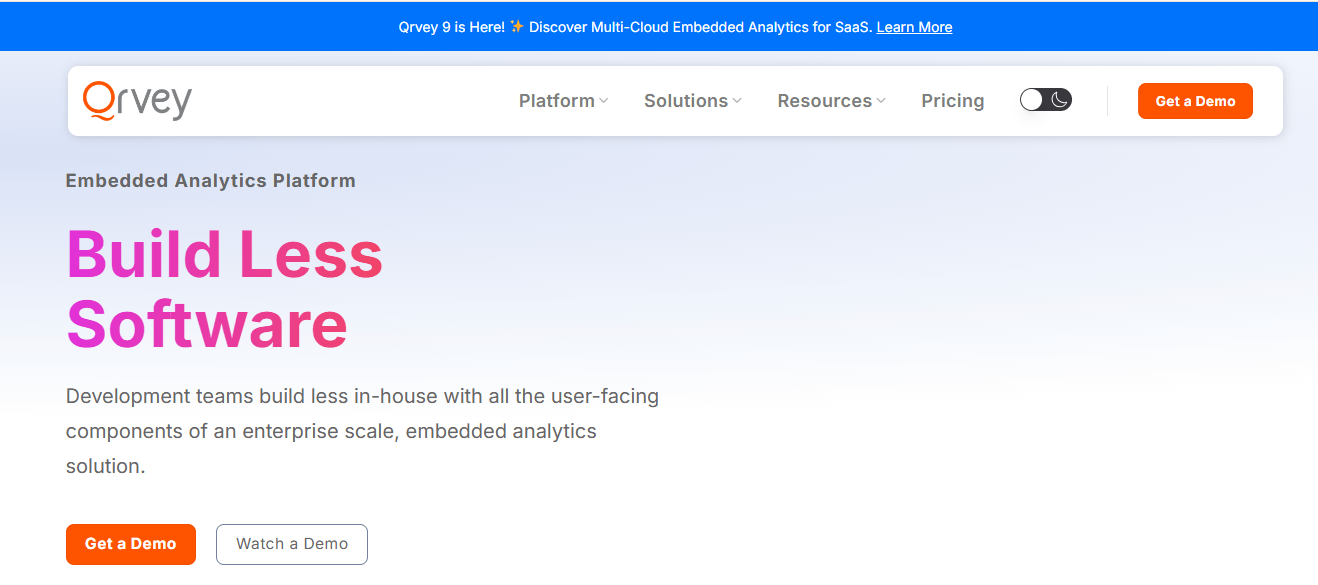
Qrvey positions itself as a leading embedded analytics platform built for SaaS providers. It takes a no-code, API-first approach that allows product teams to integrate analytics directly into their applications. Qrvey deploys entirely inside customer cloud environments, giving SaaS businesses full control while reducing development, deployment, and long-term maintenance costs.
Features
- Data Lake Integration: Built on Elasticsearch to manage large, complex datasets without slowing down
- Granular Security: Multi-tenant security works at tenant, user, and data levels, using flexible inheritance models
- Comprehensive API Tools: Enable workflow automation, predictive modeling, and AI-driven decision support
- Customizable White-Labeling: Offers full branding control with iframe-free embedding for a native app feel
- Supports unrestricted dashboards, users, and deployment environments
- No-code reporting tools let non-technical users create and edit reports independently
- Environment Replication: Teams can mirror production across multiple development environments without restrictions
Pros
- White-label capabilities ensure analytics fit seamlessly with brand identity
- Multi-tenant architecture eliminates the need for complex, manual security setups
- Elasticsearch-backed data lake ingests and processes diverse datasets without requiring ETL pipelines
- Unlimited environment deployments make testing and scaling faster and more cost-effective
Cons
- Focuses on multi-tenant SaaS environments, limiting its value for single-tenant companies
- Primarily supports external-facing analytics, not internal BI use cases
- Pricing details are available only on request, making cost evaluation less transparent
Pricing: Available on request
Best For: SaaS companies that require embedded analytics with strong multi-tenant and white-labeling capabilities.
2. Embeddable
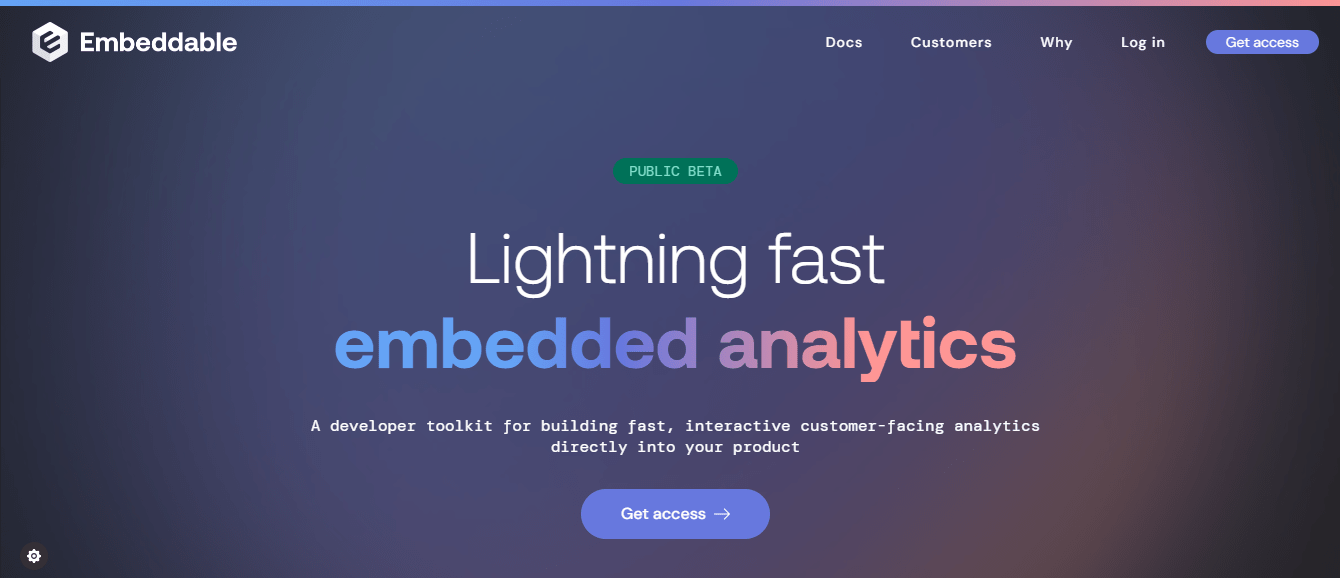
Embeddable is a developer toolkit that helps you build customer-facing analytics experiences faster than traditional methods. It works as a JavaScript SDK for businesses that want to integrate advanced analytics into their platforms. The toolkit combines the adaptability of custom-built software with the ease of business intelligence tools.
Features
- Headless architecture that gives developers complete control at the code level
- Embedding options through React components or web elements (no reliance on iframes)
- Ability to import your own charting libraries and user interface elements
- Built-in no-code builder to design and adjust dashboards quickly
- Configurable caching for faster dashboard load speeds
- Row-level security with access controls suitable for both single-tenant and multi-tenant environments
Pros
- Offers deep customization and supports imported charts
- Produces fast-loading dashboards with a native user experience
- Reduces developer workload with a built-in no-code builder
- Adapts easily as your product scales
Cons
- Demands developer input for setup and ongoing complex customizations
- Built-in charts are flexible but provide fewer instant customization choices compared to some alternatives
Pricing
Embeddable offers custom pricing based on each company’s requirements.
3. Luzmo
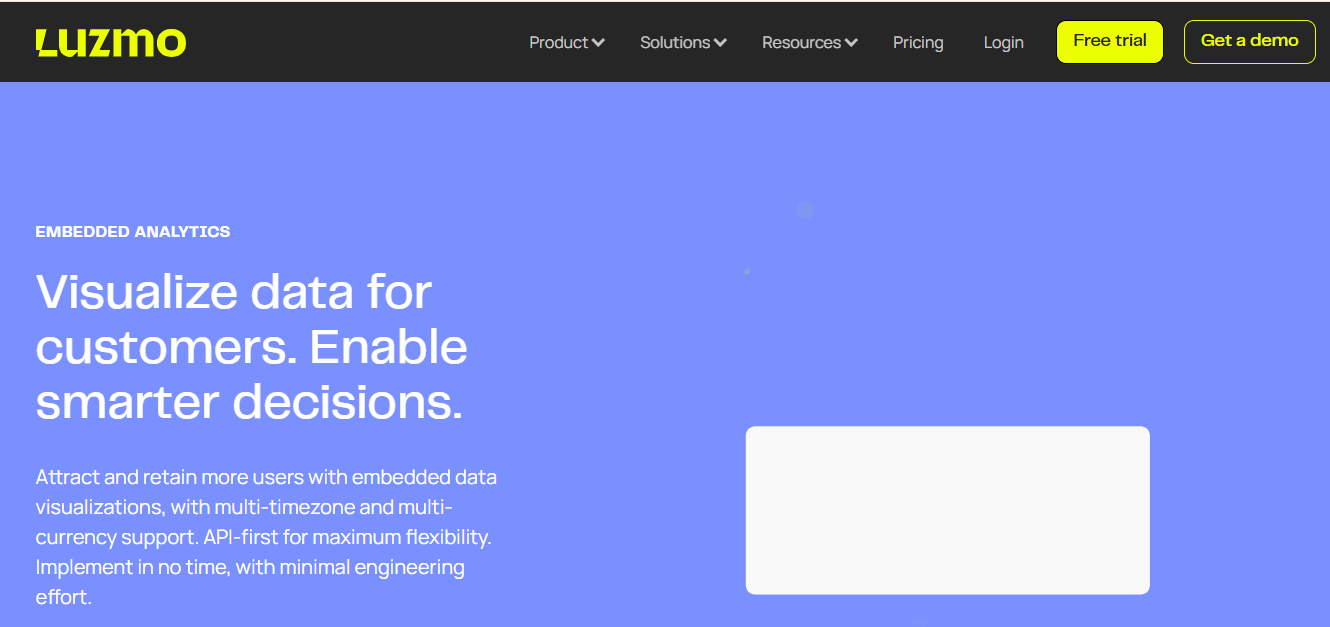
Luzmo is an embedded analytics software designed for SaaS companies. It transforms complex data into visually engaging dashboards that fit directly into any SaaS or web platform. Product teams can integrate Luzmo within days instead of months, enabling users to move quickly from raw data to actionable decisions.
Features
- Offers an intuitive drag-and-drop dashboard editor for easy setup.
- Provides AI-powered insights in plain English, making analytics accessible without technical knowledge.
- Includes a fully embeddable dashboard editor so end-users can explore data independently.
- Enables quick embedding through simple code snippets or prebuilt libraries for React, Angular, and Vue.
Pros
- Deploys embedded analytics faster than many competing platforms.
- Easy for both technical and non-technical users to work with.
- Strong customization options for teams that want deeper control.
Cons
- Costs increase significantly for large-scale SaaS implementations.
- Multi-tenant security features lag behind enterprise-grade solutions.
- Performance may drop when handling very large or complex datasets.
Pricing
- Basic Plan: $995 per month
- Pro Plan: $2,050 per month
- Elite Plan: $3,100 per month
Best For
SaaS companies that need embedded analytics with fast deployment and interactive dashboards.
4. Reveal BI
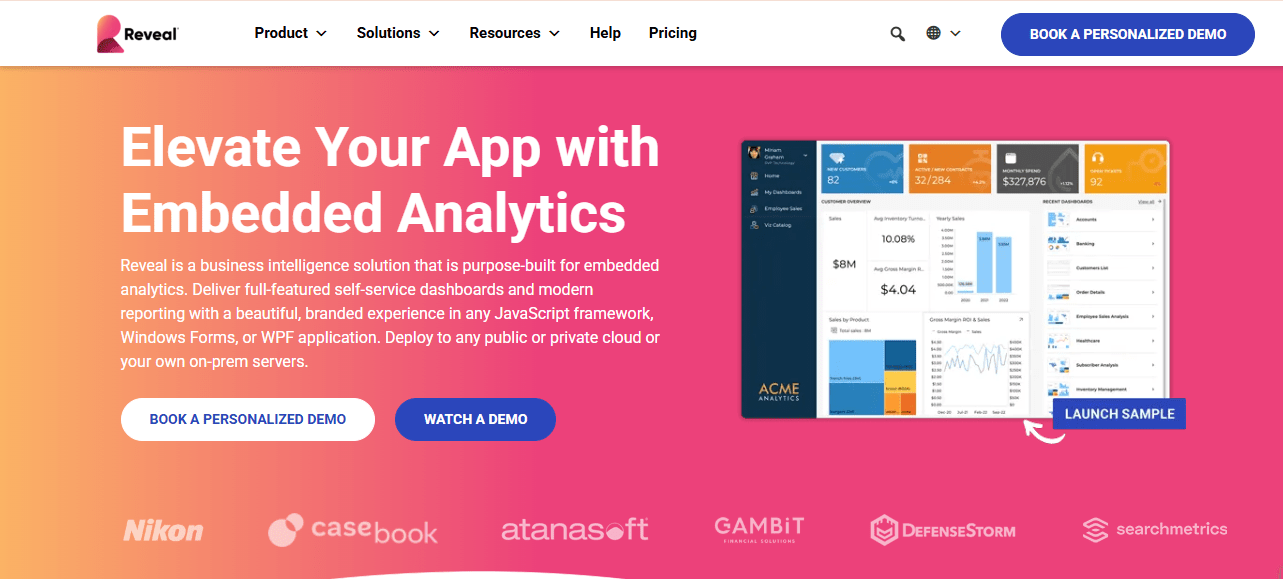
Reveal is an embedded analytics platform that integrates directly into your applications and transforms how users interact with data. Instead of relying on basic iframe integration, Reveal uses an SDK that gives developers greater flexibility. With this SDK, teams can adjust branding, modify features, set security controls, and manage deployment strategies. Reveal also works across different cloud providers, back-end frameworks, and operating systems.
Features
- Drag-and-drop tools that make dashboard creation simple
- Predictive analytics for future trend insights
- Dashboard linking to connect multiple views
- Data blending to combine information from different sources
- Calculated fields for advanced data manipulation
- Statistical analysis functions
Pros
- Gives organizations full control over hosting and data security
- SDK model allows extensive customization of analytics inside apps
- Works across different environments without heavy compatibility issues
Cons
- Lacks built-in data management or data lake support
- Setup and maintenance demand advanced technical knowledge
- Offers only limited support for multi-tenant environments
Pricing
- Available on request (demo required)
Best For
Businesses that want a self-hosted embedded analytics solution with SDK-driven customization.
5. Yellowfin BI
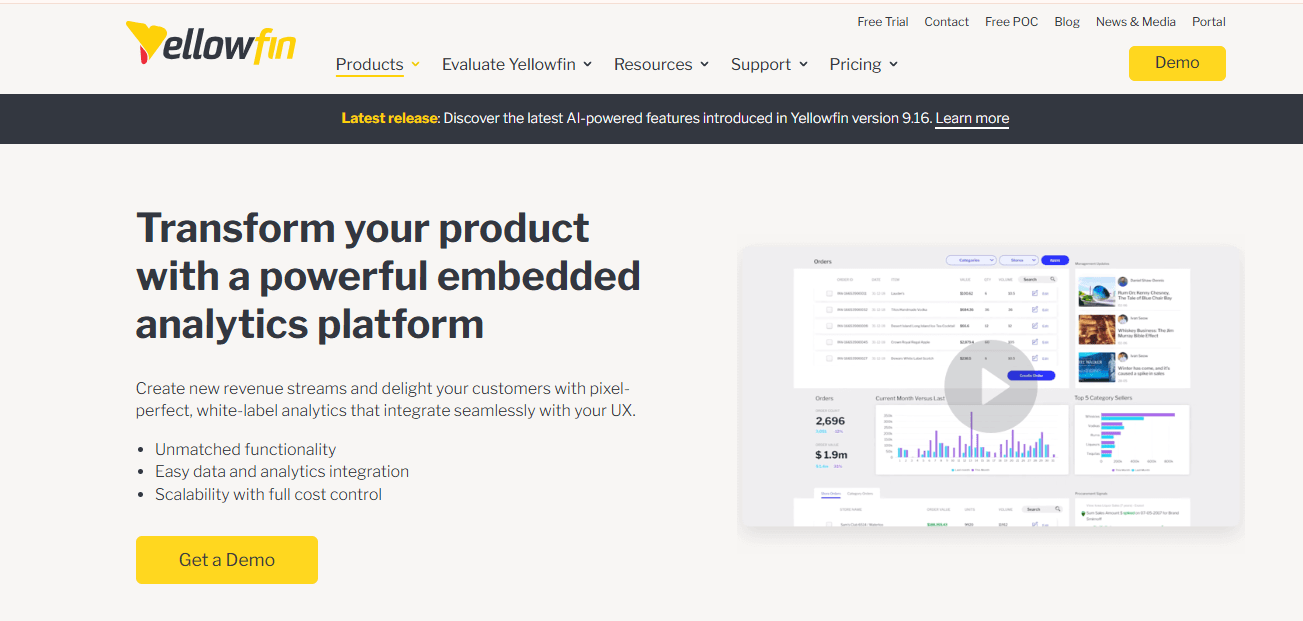
Yellowfin is a business intelligence platform that emphasizes action-based analytics and automated monitoring. It helps teams transform raw data into meaningful stories through collaboration and data storytelling tools. The platform combines reporting, dashboards, and visualization features to reduce reliance on technical expertise. Users can connect it to relational databases, cloud platforms, and big data systems. Yellowfin supports both real-time exploration and scheduled updates, ensuring timely insights for different business operations.
Features
- Alerts that allow users to trigger workflows directly from dashboards
- AI-powered automated insights that detect patterns in data
- Interactive dashboards that support operational and ad-hoc reporting
- Data storytelling functions that turn visuals into clear narratives
- Connectivity with a wide list of data sources, including cloud and big data platforms
Pros
- Automated data storytelling explains insights without requiring deep analysis
- AI assistance shortens the time needed to identify trends and anomalies
- Collaboration tools encourage teams to work together on data-driven decisions
Cons
- Query speed depends on the customer’s database infrastructure
- Multi-tenant security features are limited compared to some competitors
- Scaling concurrent users requires server clustering
Pricing
Yellowfin offers a flexible pricing model that adapts to different business needs and distribution models.
Best For
Organizations that prioritize internal business intelligence and want automated data storytelling to simplify decision-making.
6. Sisense
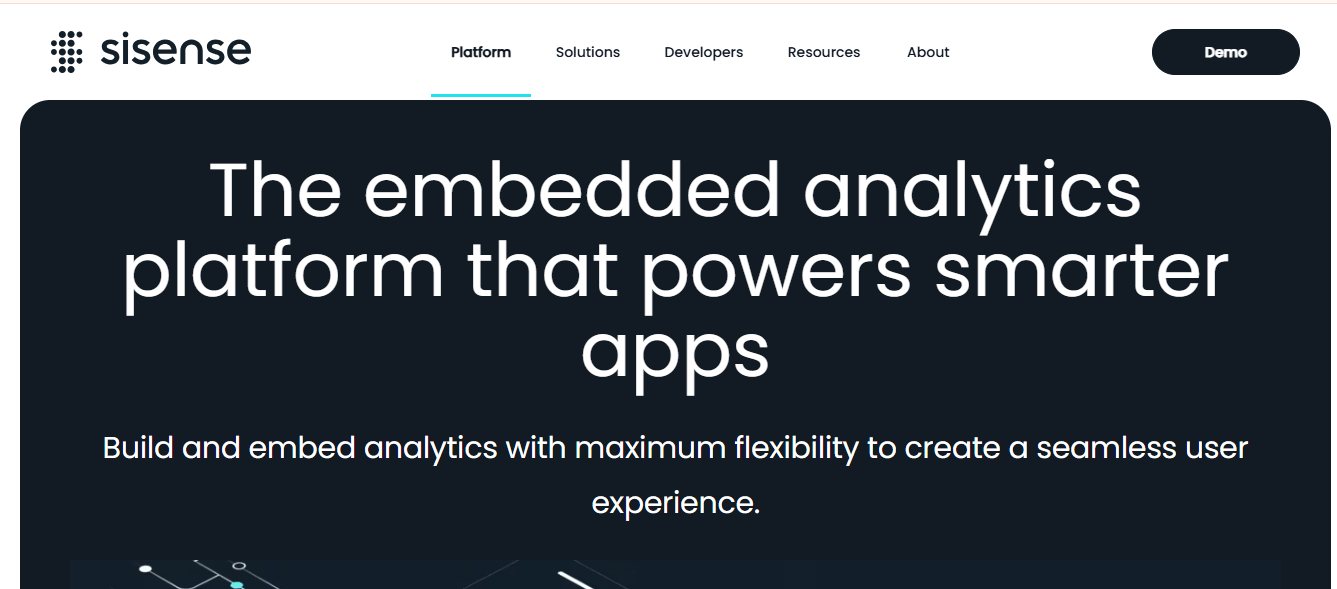
Sisense delivers an embedded analytics platform that lets companies integrate data-driven insights directly into their products and services. It uses a single-stack architecture, embeddable widgets, and data mashup capabilities to provide real-time, interactive analytics. Developers can use its SDKs to customize dashboards for different use cases, from internal business intelligence to external-facing applications.
Features
- Developer SDK for building and customizing dashboards
- Multiple UI modification options
- API support for embedding analytics into apps
- Self-service reporting tools
- Data mashup capability for combining different sources
Pros
- Offers strong SDKs for advanced customization
- Visualization engine can process complex analytics tasks
- Flexible UI components make integration easier
Cons
- Some advanced tools may require extra costs
- Self-service functions remain limited compared to other platforms
Pricing
Custom pricing available upon request.
Best For
Companies that want to embed analytics directly into their products using a single-stack architecture with flexible customization options.
7. Sigma

Sigma is a cloud-based business intelligence platform that lets teams analyze data without coding. It connects directly to cloud data warehouses and supports real-time exploration and visualization. Businesses can embed Sigma dashboards into their own software through an iFrame. With its spreadsheet-style interface, Sigma makes data analysis accessible to users who don’t have SQL skills.
Features
- Spreadsheet-like interface for analysis
- Direct connection to Snowflake and other cloud data warehouses
- Customizable dashboard and UI options
- Real-time visualization and exploration
- Embeddable dashboards for third-party apps.
Pros
- Familiar spreadsheet design helps Excel and Google Sheets users adapt quickly
- Strong integration with Snowflake for advanced cloud warehouse analytics
- Embedding options support product integration.
Cons
- Lacks built-in data preparation tools; external handling required
- Snowflake queries can generate high usage costs
- Multi-tenant security features remain limited.
Pricing
Available upon request.
Best For: Businesses that need spreadsheet-style analysis tightly integrated with Snowflake.
8. Qlik
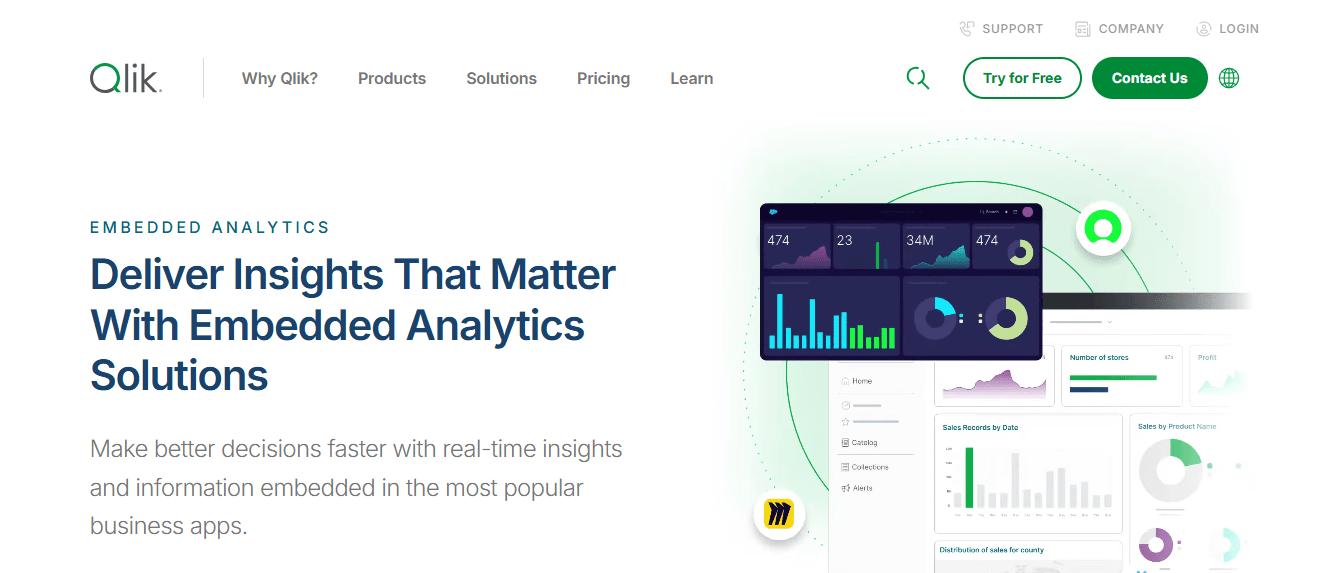
Qlik embedded analytics bring interactive dashboards and reports directly into applications. Its associative data model makes data exploration intuitive, while in-memory processing ensures fast performance. The platform integrates visual insights into end-user workflows, helping teams uncover patterns and relationships across datasets without switching tools.
Features
- iframe embedding: Integrate dashboards through the Single Integration API with minimal coding effort.
- JavaScript Capability APIs: Embed directly into the DOM with access to Qlik’s associative engine.
- WebSocket connectivity: Enable programmatic access for advanced data queries and automation.
- Web component library: Use prebuilt components compatible with React and HTML for quick setup.
- Custom extensions: Build pluggable charts and visuals using standard HTML, JavaScript, and CSS.
Pros
- Powerful tools for ad-hoc reporting and data exploration.
- Highly interactive dashboards that adapt across devices.
- Flexible options for embedding in modern applications.
Cons
- Requires skilled developers to implement advanced integrations.
- Licensing fees can be expensive for smaller teams.
- Embedding in SaaS apps may involve added complexity.
Pricing
- Starter: $250/month
- Professional: $900/month
- Enterprise: $2,600/month.
Best For
Qlik suits organizations that need advanced data modeling, highly interactive dashboards, and flexible embedding options but must be prepared for technical complexity and higher costs.
9. Power BI
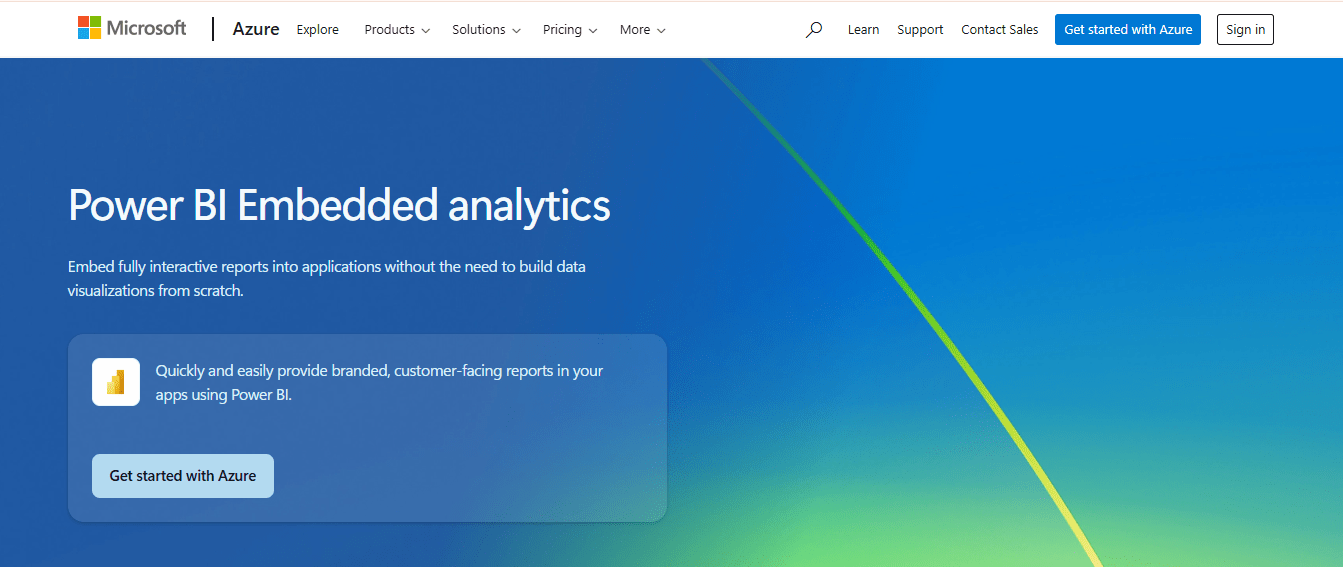
Power BI Embedded gives developers the ability to add interactive analytics directly into their applications. Teams already working within the Microsoft ecosystem benefit most because they can embed dashboards, reports, and visualizations using Azure infrastructure and familiar tools like Power BI Desktop. Instead of building visualizations from the ground up, teams rely on Power BI’s analytics engine to deliver insights inside their applications. Since the service runs within the Azure environment, the backend must always communicate with Azure to authenticate and access content.
Features
- Integration with Microsoft ecosystem tools
- Broad API support for customization
- Azure-based cloud deployment
- Embeddable dashboards and reports
- Power BI Desktop compatibility.
Pros
- Easy integration for teams already using Office 365 and Azure
- APIs allow developers to customize dashboards and reports
- Strong visualization options without building from scratch
- Consistent experience within the Azure cloud.
Cons
- Licensing model creates cost unpredictability
- High concurrency can cause performance slowdowns
- Multi-tenant setups demand heavy custom development
- Dependency on Azure for all authentication and access.
Pricing
Azure-based capacity pricing begins at $750/month for A1 capacity.
Best For: Organizations deeply invested in the Microsoft ecosystem that want customizable dashboards and analytics built into their apps.
10. Tableau
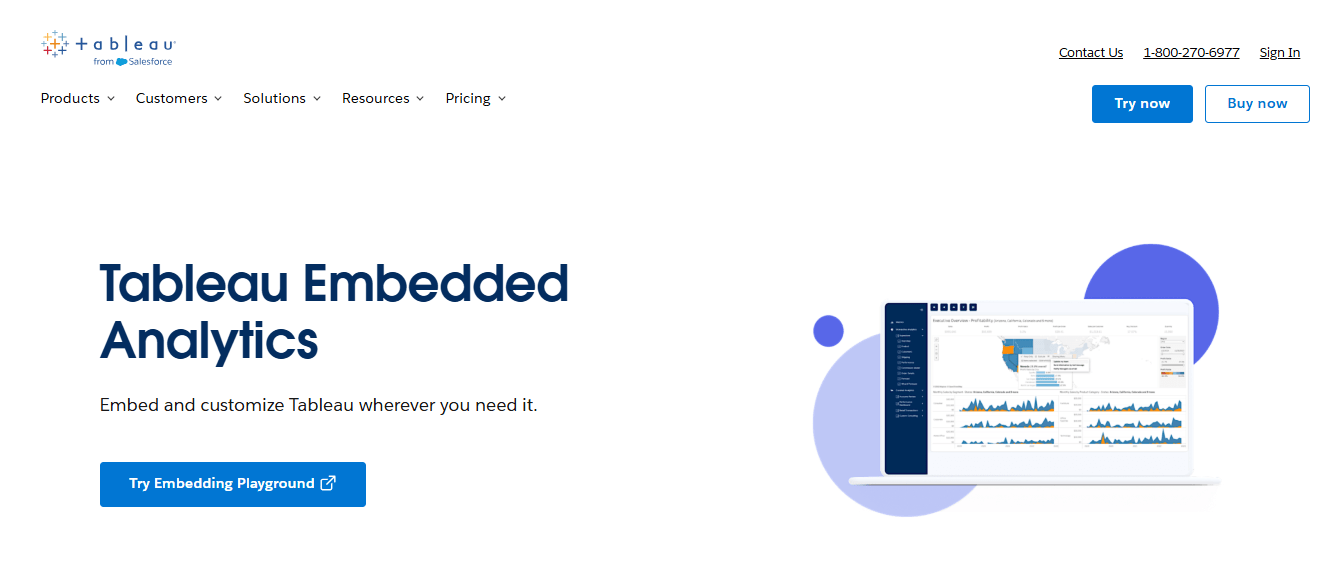
Tableau Embedded Analytics gives advanced, interactive data visualizations for users in the Salesforce ecosystem who need powerful embedded business intelligence. Many companies use Tableau to extend internal dashboards into customer-facing applications. However, its architecture can make external product integration difficult.
Features
- Interactive and advanced data visualizations
- Deep integration with Salesforce ecosystem
- Row-level security for controlled data access
- Connectivity to multiple databases, CRMs, and cloud tools.
Pros
- Tableau’s visualization engine creates polished dashboards that highlight KPIs effectively.
- Developers can integrate using a simple iFrame or use the JavaScript API for more control over placement and interactions.
- Tableau links with many data sources, including databases and cloud platforms.
Cons
- Limited design control with iFrames:
- Developers face limits when customizing embedded dashboards, reducing their ability to adapt the visuals to unique application needs.
Pricing
Tableau does not publish embedded analytics pricing. Interested teams must contact the sales department for a custom quote.
Best For: Salesforce teams that require advanced visualization tools within their applications.
11. Looker
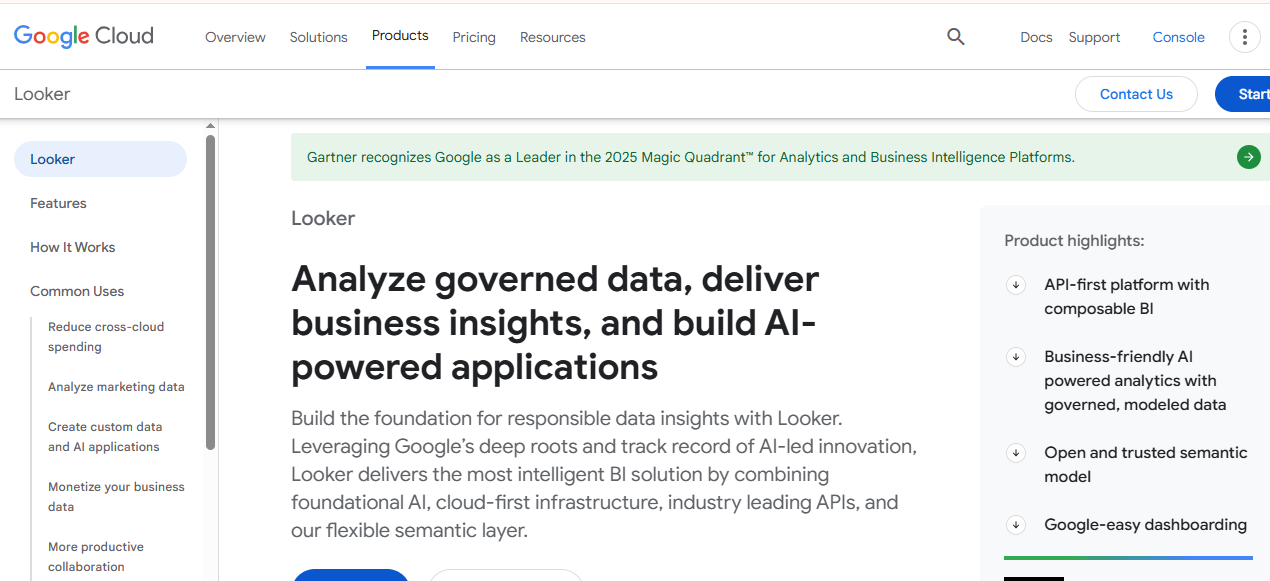
Looker, a Google Cloud analytics platform, helps businesses bring insights directly into the tools they use. Companies can embed dashboards, reports, and analytics inside applications, websites, or portals. Using LookML, a modeling language. Looker defines how data is organized and calculated, ensuring everyone across the business sees consistent metrics and results.
Features
- Direct integration with Google Cloud and BigQuery
- APIs that support custom embedding and automation
- LookML for reusable data definitions
- Built-in governance for consistent metrics
Pros
- Unified data modeling with LookML
- Smooth connection to Google Cloud services
- Strong data governance and security controls
- Developer-friendly for embedding analytics into apps
Cons
- Limited customization for interface design
- Learning curve for new users and developers
- Pricing may be complex for smaller teams
Pricing
- Custom pricing based on usage and deployment needs
Best For
- Organizations already using Google Cloud that require advanced analytics and consistent data modeling.
12. AWS QuickSight
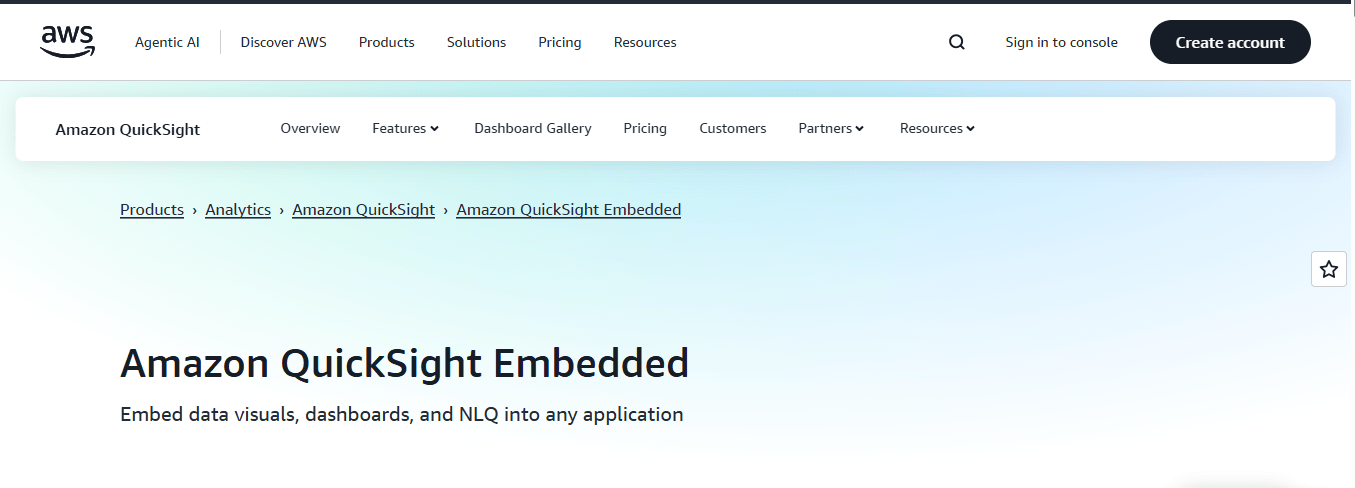
AWS QuickSight offers a cloud-native business intelligence and embedded analytics directly within AWS environments. It connects to multiple data sources such as Amazon Redshift, Amazon Athena, Amazon S3, and Presto, enabling teams to access and fetch data with ease. Developers can embed interactive dashboards and create modern paginated reports. The platform also supports natural language queries, allowing users to generate analytical insights without writing complex code.
Features
- Direct integration with core AWS tools
- Predictive insights powered by machine learning
- Embedded dashboards for applications and portals
- Natural language query functionality
Pros
- Machine learning generates predictive insights automatically
- AWS-native integration supports businesses already using the cloud ecosystem
- Supports both interactive dashboards and paginated reports
- Natural language queries make analytics accessible to non-technical users
Cons
- Interface design feels less intuitive than specialized BI tools
- Multi-tenant security often needs additional development effort
- Limited branding and customization options for embedding.
Pricing
Pricing varies by usage and role-based access.
Best For: Businesses operating primarily within AWS that need embedded dashboards and machine learning-driven insights.
13. Domo
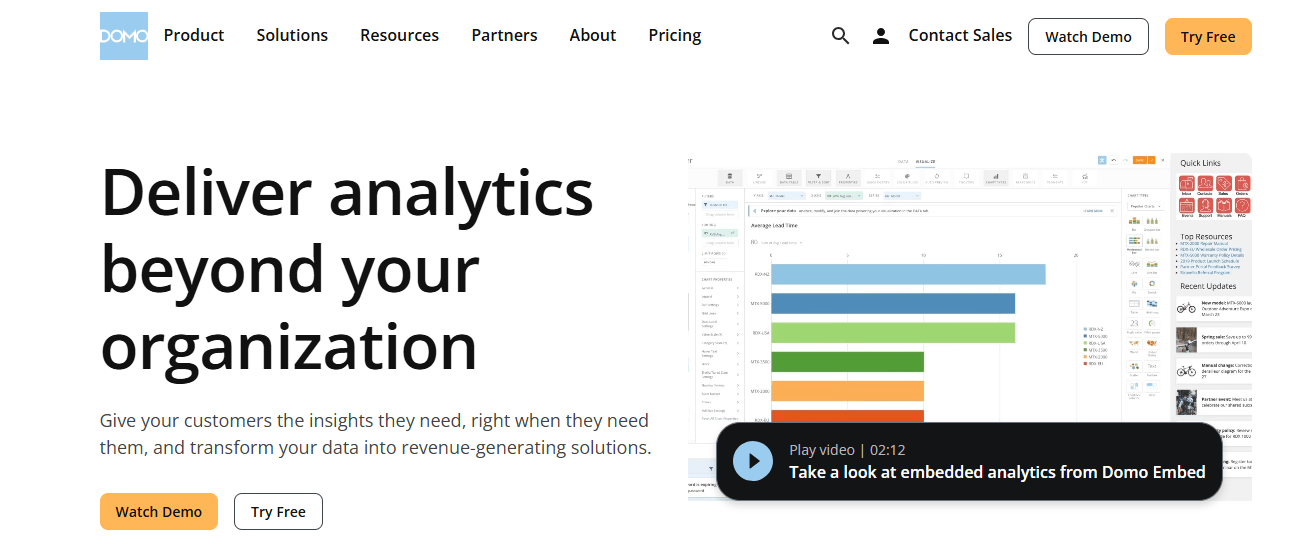
Domo provides embedded analytics tools that allow organizations to place data-driven insights directly inside their applications, partner programs, and workflows. Its customizable dashboards, real-time data updates, and built-in security make it possible to integrate analytics without relying on separate systems. The platform stands out for its simple interface, which helps non-technical users build dashboards and uncover insights quickly. Teams can also create and deploy custom data apps with minimal effort.
Features
- API support that enables developers to connect and extend data sources
- Cloud-based design for flexibility and easy deployment
- Self-service business intelligence tools that reduce reliance on IT teams
- Custom dashboards with real-time updates
- Security controls that protect sensitive business data
Pros
- Dashboards refresh automatically with real-time data integration
- Visualizations adjust to different business requirements
- Non-technical users can build and manage analytics without coding
- Works across applications, workflows, and partner ecosystems
Cons
- Licensing for embedded analytics can be costly
- Multi-tenant security features remain limited
- Complex customizations often require advanced technical skills
- Setup for large enterprises may take longer than expected
Pricing
Custom enterprise pricing based on usage and organizational needs.
Best For: Businesses that need real-time business intelligence with flexible visualization options.
Selecting embedded analytics software starts with your business goals, technical skills, and budget. The tools in this guide bring different strengths to different situations.
The most effective option usually balances four key points: how smoothly it connects with your current systems, the level of control it gives you to customize, the flexibility of its pricing, and the security it provides as your business expands. Start by defining your main goal, offering analytics to customers, strengthening internal decision-making, or giving partners access to data then focus on solutions that stand out in that area while still supporting future growth.

